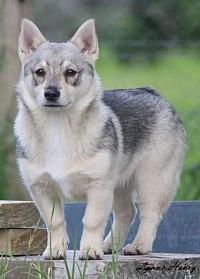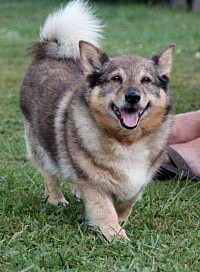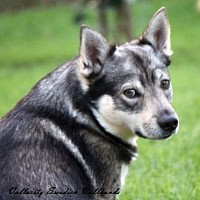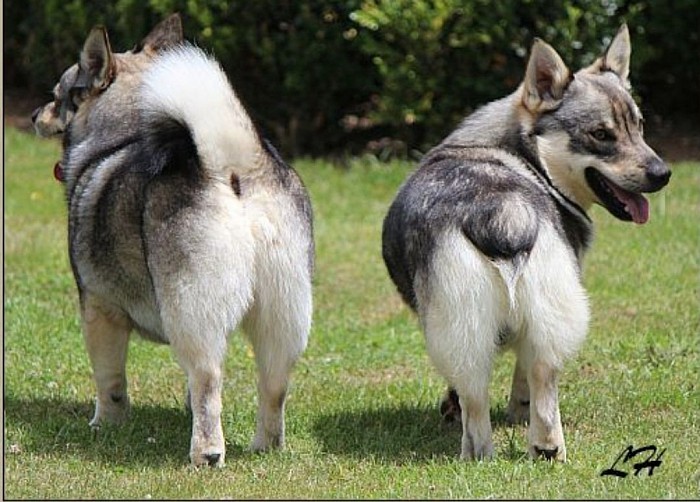Breed Conservation
Conservation
Conservation efforts are being made to preserve diversity and rare bloodlines!
With only 7% Diversity, 2 Matrilines and 2 Patrilines: one of each being extremely rare, we believe it is vital to protect the 2 rare lines for the future of the breed. While still health testing and DNA profiling , we are working on a breeding programme that will see these lines expanding back into the very limited gene pool.
We are sending our dogs DNA to UC Davis, USA, for diversity testing and Betterbred diagnostic tools. This ensures that our mating selections will contribute to the genetic diversity of our breed - which equates to longevity and health.
What is a Matriline?
"A matriline is a line of descent from a female ancestor to a descendant via a line of females. A matriline can be drawn from todays females all the way to the females of the foundation stock: from daughter to mother, grandmother, great-grandmother and so on.
Mitochondria are the power plants of the cell: They supply cell with energy. In addition to that, mitochondria have their role in regulating the cycle, growth and death of cells. In a Matriline, the mitochondrial DNA (mt DNA) has descended from a mother to a daughter. Males also inherit mtDNA from their mother, but they cannot pass it on. Offspring inherits mtDNA always from the mother, and the genes of the father do not affect mtDNA in any way. If the matriline is broken, the mtDNA of that line is lost.
There are only two matrilines left among Swedish Vallhunds.
What is a Patriline?
A patriline is a father line, or a sire line as it could be called in the dog world. A patriline is a line of descent from a male ancestor to a descendant via line of males: a sire, his sire and his sire, and so on. Males Y chromosome descents in the patriline.
Out of these 13 patrilines, 11 have died out
Today, there are only two intact patrilines: Mopsens and Tjappos. Tjappos line is hanging by a thread. If Tjappos patriline disappears, there is only one version of chromosome Y and the DNA it contains left in the breed"
Credit: Halla Seppala, Konnunkoden Swedish Vallhunds (Finland)
Rare Lines at Vallarity
The rare 6% Tussi Matriline
Vallarity Penny Arcade
Vallarity Vallkyrie
The Very rare 1% Tjappo Patriline
NZCH Vallarity Rockabilly Rebel
Vallarity Optimus Prime
NZCH Vallarity Elfin Oak
Vallarity Limmerick
Less than 1% Very Rare Haplotypes 1009, 2022
Vallarity Wood Nymph
Vallarity Lilliput Wood
Vallarity Limmerik
Breed Diversity testing done through UC Davis, USA and in conjuction with Betterbred Diagnostics, we are able to identify Internal Relatedness as well as the rare haplotypes, along with a multitude of genetic information for each dog, pairing and breed for diversity, health as well as retaining the characteristics of the breed through careful puppy selection.
BREED DIVERSITY
Several years ago I was involved with Massey University NZ to create the first Genetic Diversity test for dogs worldwide using the Swedish Vallhund. Since then the test has been picked up Internationally, refined and used on a wide range of breeds including another two further tests performed on the Swedish Vallhund.
The latest Genetic Diversity Test has been run by UC Davis in America and been published in conjunction with Betterbred. So why is Genetic Diversity so important in dog breeds??
(articles kindly supplied by Betterbred) Diversity is the Spice of Life! Inbreeding, bottlenecks, popular sires, and selective breeding in the past are a few factors that can restrict a breed’s gene pool and may eventually lead to increased inherited diseases, weaker immune systems, cancers, reproductive problems, and smaller litter size. Agene pools lose genetic diversity, breed specific diseases tend to increase.
This genetic diversity research has provided information on the diversity status of your breed as a whole and provided recommendations how the breed might maintain diversity it has retained after stud book closure.
It tells us how closely related our dogs actually are, regardless of pedigree, and shows the overall level of diversity present within the breed. Individual dogs receive data demonstrating their diversity compared with the rest of the breed’s population as well as an inbreeding assessment. The information is greatly different than the Coefficient of Inbreeding (COI), which a statistical probability of risk of inheriting the same genetics from an ancestor. The COI for a litter will be the same for each puppy, whereas the genetic information provided by an individual’s DNA may tell a different story. This testing will help to identify dogs with less typical genetics that can be used to improve your gene pool.
What will it tell me about my dog?
The main parts of the study will provide breeders with a certificate which is another tool to help make better breeding decisions for the future preservation of the breed, each individual dog will be provided with the following information:
1) The DLA (immune system) haplotype of each dog, Class I and Class II
2) Will identify how inbred or outbred each dog is to the rest of the population
3) How genetically unique a dog is for its population, and how closely it is related to others in its breed. This last analysis is done on the BetterBred website.
4) BetterBred will provide materials for how to use the results in breeding programs and provide a free trial of full membership to the research members.*The Swedish Vallhund Diveristy Test Results* (Article Kindly supplied by Betterbred)We feel fortunate at BetterBred to have so many new breeds joining us, and by extension getting to know so many people dedicated to the preservation of their historic breeds. This week we are welcoming the Swedish Vallhunds. They are an ancient breed, once companions to Vikings. Welcome to Betterbred.The sample of Swedish Vallhunds in this study was from worldwide breeders. Lines represented in this initial sample hailed from Sweden, France, Finland, United States, Australia, Canada, United Kingdom, Netherlands, etc. It has been obvious that diversity is a worldwide concern of the Swedish Vallhund breeders from the very beginning, as they all worked together to seek a worldwide sample faster than any breed yet that has completed phase 1. We want to congratulate them on their efforts as a community.This week results released for the Swedish Vallhund breed on 5/16/2018. You can read the full report here. What did the prestigious team at UC Davis and Dr. Pedersen DVM PhD, professor emeritus and world renowned expert in canine genetics, find?InbreedingDr. Pedersen found the following in terms of the inbreeding values of this population:
One half of the dogs have IR values between -0.115 and +0.085, which are respectable IR scores. One fourth of the population had IR scores from -0.115 to -0.239, indicating a population that was produced by parents that were as unrelated as possible. However, one fourth of the dogs had IR scores of +0.085 to +0.435. This proportion of dogs are quite inbred and even above the level of offspring of full-sibling village dog parents. The highly inbred and outbred populations cancel each other out in the breed-wide standard genetic assessment based just on unadjusted allele frequencies.Interpretation? A fourth of this population is exceptionally inbred, however the other 3/4 of the breed have acceptable to very low inbreeding scores. The fourth of the population with very high inbreeding could be well served by verifying that their “outcross is really an outcross” or if their linebreeding is too close, with free or advanced analysis here at BetterBred.Genetic Diversity at the Breed LevelProbably the most shocking statement I have yet to read in a breed report was this: “The black area is an estimate of the amount of genetic diversity still present among dogs that has been retained in Swedish Vallhund, i.e., 7%.“Seven percent. SEVEN?! This is the lowest reported diversity estimate for a breed to date.Let that sink in. This analysis compares a breed to the best possible case scenario, wild dogs sampled for their diversity.How, then, could they possibly be healthy?However, unlike other breeds where one or two alleles predominate, Vallhund allele frequencies are more even among the existing alleles. This indicates that selection of sires and dams has tended to use the full-spectrum of available genetic diversity present at the time of registry closure. Although registry closure precludes outside introgressions, the period following closure is usually a time of intensive breed refinement and selection of animals that will produce puppies breeding true to the standards. It appears that the founding population for the Vallhund were quite “refined” and “true breeding” from the onset, as further supported by the breed history.What does this mean? The breeders in this tested sample have done a good job keeping the genetics that they have relatively well distributed, despite the genepool being depleted. We find that breeds that have done this, tend to be relatively healthy compared to those with severe bottlenecks. However, great care must be taken to ensure that this trend of distributed genetics continues, as more genetic loss may not be survivable for this breed. From the report: “A lack of genetic diversity does greatly limit a breed’s ability to adjust to further artificial genetic bottlenecks, whether they are geographic, catastrophic or genetic disease associated.”DLA – Dog Leukocyte Antigen
A Look at the Dog’s Immune SystemNot surprisingly, given the breed’s analysis in the STR panel, it was also found that the found DLA haplotypes in this breed are the lowest numbers for any breed yet investigated. There are only six class 1 and 4 Class 2 DLA types.The majority of these types are well distributed within the breed, with only a couple being in low representation. These are 1009, 1179, and 2022 (represented 5.1%, .9% and 5.1% of the tested haplotypes respectively).Breeders should make an effort to redistribute and maintain these less common types so as not to lose them to genetic drift.ConclusionsFrom Dr. Pedersen’s report: “A lack of genetic diversity does greatly limit a breed’s ability to adjust to further artificial genetic bottlenecks, whether they are geographic, catastrophic or genetic disease associated.”This breed has a shockingly low amount of genetic diversity breedwide. Thankfully the breed remains relatively healthy, compared to many other breeds depleted genetically. The reason for this health is likely twofold. First, breeders of this sample have kept their genetics well dispersed within their population. Secondly, the founding dogs were likely also very healthy. This has been an advantage for this breed, however it would take one deleterious gene in a popular sire for this breed to suffer disastrous results.
Our RecommendationBreeders in this breed should seek out more dogs that may have different genetics; testing more dogs and potential studs will help contribute. If no more is found, breeders should ensure that they maintain what they have, both in DLA and allelic richness, by keeping the genetics well dispersed. Our website will help with these goals, and we sincerely hope the community will embrace this to move forward.




